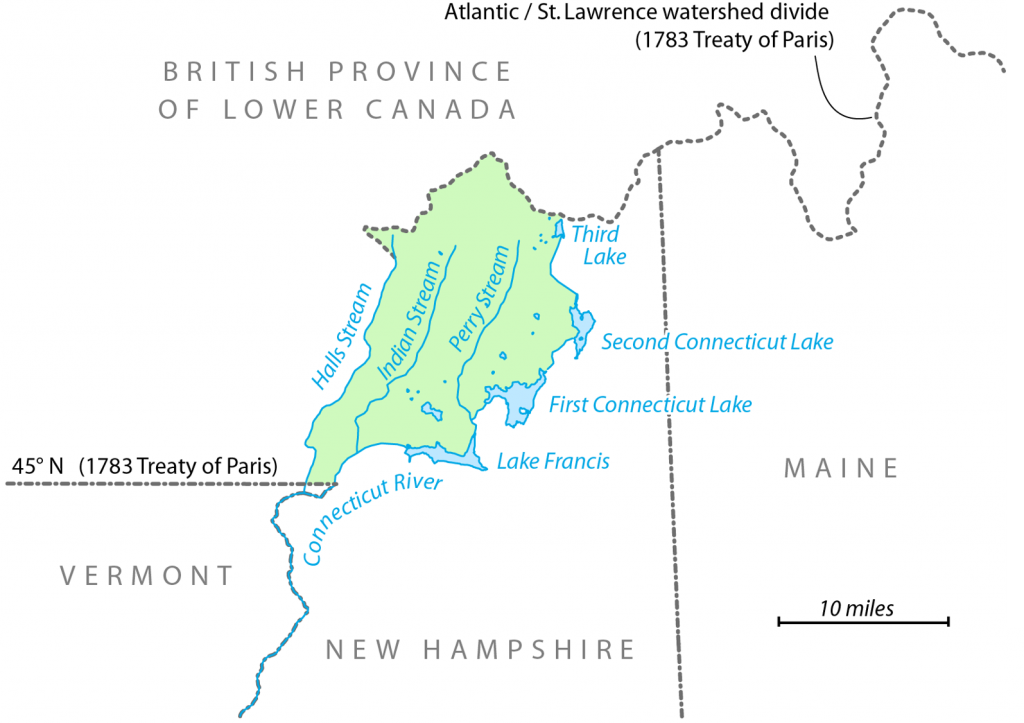When Multiple Streams Can Be Taxing
In the 1770s, a fledgling colony of Great Britain was upset about its taxes. Known ultimately as the United States, these thirteen British colonies declared their independence from the crown in 1775. And when the British surrendered in October of 1781, the United States became its own nation. All that was needed was to put pen to paper.
That took a while, but in September of 1783, the two nations signed the Treaty of Paris, setting forth, among other things, the boundaries between the United States and the UK’s remaining territories in North America. But in at least one case, the treaty left some ambiguous borders — and as a result, a small nation that wanted to be independent from both the U.S. and the UK.
Let’s start with a map.

Toward the western part of the map, where Vermont is, the border is straightforward (and straight) — it’s the 45th Parallel. In the east, it’s also rather clear — the St..Lawrence River divides the two nations. But between those two, there’s a problem. According to the Treaty, the border is where “the northwesternmost head of the Connecticut River” is — but that can be tricky. At around where the Connecticut hits the 45th Parallel, it veers to the northeast. So where, exactly, is the border? Depends.
The United States argued that Halls Stream, the westernmost tributary of the River (at least up north), should be the border. Great Britain argued that the River itself, capped by “Third Lake,” should be the border, as the river’s head is there. And both nations tried to enforce their definition of the border — or, more correctly, tried to monetize it. As Mental Floss notes, “the 280-square-mile patch of land between two tributaries [shown in green above] was subject to taxation by both countries.”
Very few people like to pay taxes, and even fewer like to pay them twice. So the people who lived in the region decided to pay taxes to none of the above. By the 1820s, they had called themselves the Indian Stream Territory, at least informally. And on July 9, 1832, they made it officially — the Indian Streamers declared themselves a free and sovereign state. And they were serious. Atlas Obscura explains:
The Republic of Indian Stream was no laughing matter—its less than 300 residents were committed enough to draft a constitution, print their own stamps, establish a 41-man militia, and elect a local government. The unrecognized state received so much attention that it was the subject of diplomatic discussions between British ambassadors and American President Andrew Jackson and even appeared in the 1830 Census as “Indian Stream Territory, or so-called.”
Neither the U.S. nor Britain were okay with this outcome. In August of 1835, the New Hampshire government told Indian Stream to cut the BS and (re-)join the state, or risk being forcibly occupied; after a meeting between the New Hampshire sheriff and the Indian Stream militia, the revolutionaries decided to take that threat seriously and agreed to be annexed by the United States, ending their three years of quasi-independence. Great Britain didn’t recognize this, though, and in the fall of the same year, arrested an Indian Stream for failing to pay a debt owed to a local hardware store. The US didn’t want its citizens being prosecuted by the British, and this otherwise-middling dispute became an international incident.
It did not, however, boil over from there. Realizing how incredibly stupid it would be to (once again) go to war with its former colonies, Great Britain capitulated. The border, as it stands today, is what the United States claimed at the beginning of the imbroglio. More than a half-century after the Treaty of Paris created the ambiguity, the two sides officially clarified it in the Webster-Ashburton Treaty of 1842.
Bonus fact: Had Indian Stream remained in the United Kingdom, it may have been somewhat safer today. According to the Governors Highway Safety Association, 49 of the 50 U.S. states have laws requiring that adults wear seat belts in cars (although not all of them require seat belts if you’re an adult passenger); New Hampshire is the only exception. Quebec, where Indian Stream would be had it been part of Canada, requires the wearing of seat belts.
From the Archives: Rock the Gazbar: More fun with the U.S./Canada border
